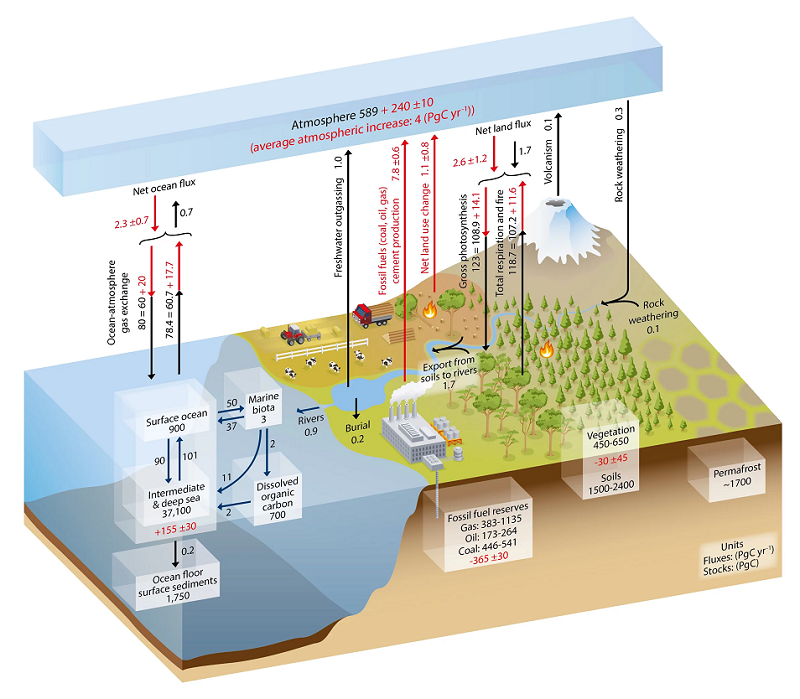What are Biogeochemical Dynamics?
Biogeochemistry is the study of the biological, geological, and chemical processes that occur in nature, and biogeochemical dynamics are the complex interactions between these processes including how the interactions change over time. In particular, biogeochemistry examines the factors that influence cycles of key elements such as carbon, nitrogen, and phosphorous and the impacts of the elements as they flow through the reservoirs in the Earth system--the atmosphere, hydrosphere (water and ice), biosphere (life), and lithosphere (rock).
The Carbon Cycle
The carbon cycle involves the storage and fluxes of carbon, in its many phases, throughout the Earth system. Carbon dioxide (CO2) represents the primary atmospheric phase of carbon. Carbon can move from the atmosphere to the terrestrial biosphere through photosynthesis, where it is stored in living biomass (plants and animals) and in dead matter (litter and soils). Carbon can cycle back into the atmosphere through respiration or through the burning of materials that contain carbon. As a greenhouse gas, CO2 in the atmosphere absorbs heat and contributes to the regulation of Earth's temperature.
The ORNL DAAC archive has many datasets related to the carbon cycle in terrestrial ecosystems. Scientists use these data to study the long- and short-term trends of the carbon cycle and how changes to the carbon cycle affect the Earth system.

References & Recommended Links
Ciais, P., C. Sabine, G. Bala, L. Bopp, V. Brovkin, J. Canadell, A. Chhabra, R. DeFries, J. Galloway, M. Heimann, C. Jones, C. Le Quere, R.B. Myneni, S. Piao and P. Thornton, 2013: Carbon and Other Biogeochemical Cycles. In: Climate Change 2013: The Physical Science Basis. Contribution of Working Group I to the Fifth Assessment Report of the Intergovernmental Panel on Climate Change [Stocker, T.F., D. Qin, G.-K. Plattner, M. Tignor, S.K. Allen, J. Boschung, A. Nauels, Y. Xia, V. Bex and P.M. Midgley (eds.)]. Cambridge University Press, Cambridge, United Kingdom and New York, NY, USA. https://www.ipcc.ch/report/ar5/wg1/carbon-and-other-biogeochemical-cycles/
Galloway, J. N., W. H. Schlesinger, C. M. Clark, N. B. Grimm, R. B. Jackson, B. E. Law, P. E. Thornton, A. R. Townsend, and R. Martin, 2014: Ch. 15: Biogeochemical Cycles. Climate Change Impacts in the United States: The Third National Climate Assessment, J. M. Melillo, Terese (T.C.) Richmond, and G. W. Yohe, Eds., U.S. Global Change Research Program, 350-368. doi:10.7930/J0X63JT0. https://nca2014.globalchange.gov/report/sectors/biogeochemical-cycles
Purdue Ecosystems & Biogeochemical Dynamics Laboratory. 2017. The Terrestrial Ecosystem Model. https://www.eaps.purdue.edu/ebdl/resources/ecosystems-biochemical.html
Riebeek, H. 2011. The Carbon Cycle. NASA Earth Observatory. http://earthobservatory.nasa.gov/Features/CarbonCycle/
Schimel, D.S. 1995. Terrestrial biogeochemical cycles: Global estimates with remote sensing. Remote Sensing of Environment, 51(1), pp.49-56. https://doi.org/10.1016/0034-4257(94)00064-T
University Corporation for Atmospheric Research Center for Science Education. 2011. Biogeochemical Cycles https://scied.ucar.edu/longcontent/biogeochemical-cycles